1. Introduction
In the plant embryo, all cells can divide and later differentiate into functional mature cells. Meristems are groups of undifferentiated cells found in some regions of the adult body of the plant. Meristematic cells proliferate and differentiate into a wide variety of cells and are responsible for the continuous growth of the plant.
Meristems can be permanent and functional along the plant'sv lifespan, as happens to the shoot and root apical meristems. Others are transient and function for a limited period of time, such as those giving rise to v leaves, flowers, and petioles. Some meristems may appear quite late after germination, such as the phelloderm and vascular cambium.
Meristematic cells show features of undifferentiated cells: they are small, isodiametric, and have a very thin primary cell wall. The cytoplasm is rich in ribosomes, proplastids, and many small vacuoles but is poor in endoplasmic reticulum and inclusions. A well-developed Golgi complex synthesizes the components of the cell wall. The large nucleus contains condensed chromatin and is located centrally. Meristematic cells are totipotent, i.e., they are able to differentiate into the entire variety of cell types of the adult plant. The particular cell type and function a differentiated cell performs are determined by position of the meristematic cell in the meristem and the signals found in that place.
The classification of meristems is based on their topographic position in the body of the plant and on the time they appear during plant development (Figure 1).
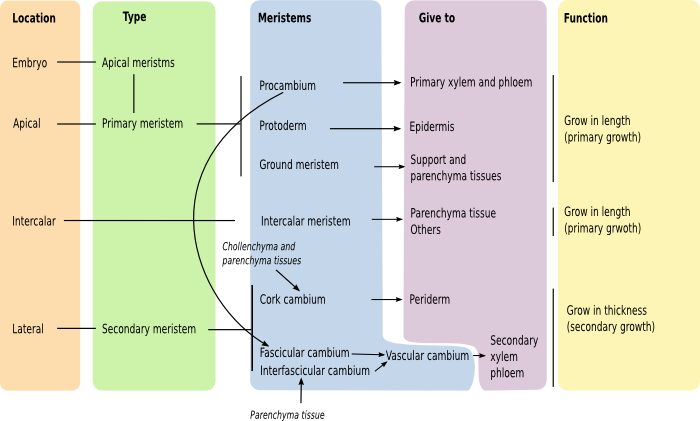
2. Primary meritems
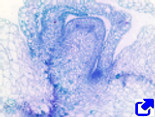
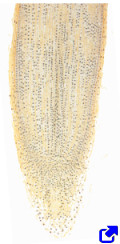
Primary meristems are first observed in the embryo and primarily contribute to the growth in plant length (Figure 2). Primary meristems are found at the ends of the main and lateral shoots and roots, and hence they are called shoot apical meristems and root apical meristems, respectively. Axillary buds, which give rise to branches, are derived from the shoot apical meristem. Branches bear an apical meristem, similar to the shoot apical meristem. However, the apical meristems of the lateral roots are formed from the root endodermis. Shoot apical meristems are covered and protected by thec leaf primordia, whereas the root apical meristem is wrapped by the calyptra. Other meristems are formed from the apical meristems: the protodermis differentiates into the epidermis, the procambium gives rise to the primary vascular tissues, and the ground meristem is responsible for the rest of the cell types within the plant.
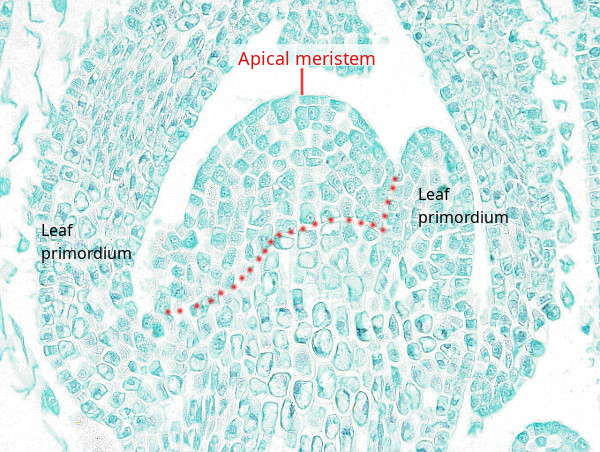
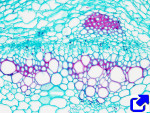
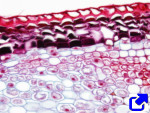
However, in monocots, most of the growth in length of shoots depends less on the apical meristems and more on the intercalary meristems. Intercalary meristems are found between nonmeristematic tissues. The best-known examples of intercalary meristems are those located in internodes (primarily at the base of the internodal region) and in the leaves.
3. Secondary meristems
In those plants that grow in thickness, i.e., have secondary growth, additional kinds of meristems known as lateral or secondary meristems can be found (Figure 1). These meristems arise later during development and are responsible for the increase in diameter of shoots (producing the wood and bark) and roots. These meristems are typical of gymnosperms and dicot plants. There are two types of lateral meristems: the vascular cambium, which derives from the procambium and produces secondary vascular tissues (secondary xylem and secondary phloem), and the cork cambium (phellogen), which produces bark. Both meristems are arranged as a continuous cylinder, sometimes as an incomplete ring, along shoots and roots.
4. Other meristems
There are two additional meristems involved in the development of the vascular system: provascular and preprocambium. The provascular tissue is an embryonic tissue located in the prospective vascular cylinder. Preprocambium cells are found in leaves and are the precursors of procambium. They cannot be distinguished from the ground tissue cells.
New meristems may arise from dedifferentiation of parenchyma and collenchyma cells, as well as from the root endodermis.
In monocots, the secondary growth was lost during evolution, possibly because all the procambium meristem is differentiated into vascular tissues. The growth in thickness of monocot stems and roots is a consequence of the increase in size of the cells. However, palms and other monocots with tree-like bodies (some asparagales) may develop very thick stems by adding new parenchyma cells and more vascular bundles in regions far away from the apical meristems. This kind of growth is called anomalous growth and is produced by the appearance of a new type of meristem known as the peripheral growth meristem.
-
Bibliography ↷
-
Augstein F, Carlsbecker A. 2018. Getting to the Roots: A Developmental Genetic View of Root Anatomy and Function From Arabidopsis to Lycophytes. Frontiers in plant sciences. 9: 1410. DOI: 10.3389/fpls.2018.01410.
Miyashima S, Sebastian J, Lee J-Y, Helariutta Y. 2013. Stem cell function during plant vascular development. EMBO jouranl. 32: 178-193. DOI: 10.1038/emboj.2012.301.
Truskina J, Vernoux T. 2018. The growth of a stable stationary structure: coordinating cell behavior and patterning at the shoot apical meristem.Current opinion in plant biology. 41: 83-88. DOI: 10.1016/j.pbi.2017.09.011.
-
 Introduction
Introduction 